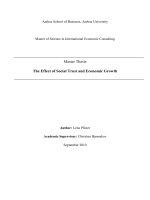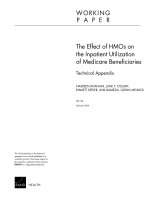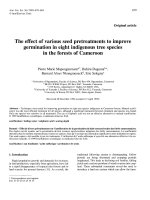The effect of carbohydrate rich diet to exercise high intensityexercises
Bạn đang xem bản rút gọn của tài liệu. Xem và tải ngay bản đầy đủ của tài liệu tại đây (63.25 KB, 11 trang )
<span class='text_page_counter'>(1)</span><div class='page_container' data-page=1>
<b>Direct Comparisons of Fuel use during Low, </b>
<b>Moderate, and High Intensity Exercises </b>
Researched and Composed by Jacob Wilson, BSc. (Hons), MSc. CSCS. and Gabriel
“Venom” Wilson, BSc. (Hons), CSCS.
<b>Abstract</b>
Several studies have examined and compared the effect of exercise intensity on
substrate utilization. The purpose of this paper was to provide insight on these
findings.
<b>Exercise Intensities Compared in terms of Fat Oxidation during the </b>
<b>Exercise Session</b>
In one of the most well composed studies in modern times, Romijn et al. (1995)
investigated the effect of intensity and duration on substrate utilization during
exercise. Participants consisted of six trained endurance athletes, while the
apparatus consisted of a cycle ergometer. Exercise was performed at 25, 65, and 85
% V02 maximal capacity. Whole body carbohydrate as well as lipid oxidation were
measured. Carbohydrate oxidation was fractionated into fuel utilized from plasma
glucose, as well as intramuscular glycogen stores. Fat oxidation was fractionated
into exogenous fatty acids derived from adipose depots and intramuscular glycogen
stores. Whole body lipolysis was also measured.
In review, oxidation is the process by which energy is extracted from fuels. Fat
oxidation, in laymen’s terms is often referred to as fat burning. In this context whole
body lipid oxidation, would refer to the amount of total fat ‘burned’ during a
</div>
<span class='text_page_counter'>(2)</span><div class='page_container' data-page=2>
procedures allow the experimenter to extrapolate the percentage of fuel used from
carbohydrates as well as fats from this method ( for more on indirect calorimetry,
see Wilson and Venom, 2004 - Energetic Transference Occurring in the Biosphere
Part I ). Endogenous or peripheral carbohydrate and lipid oxidation were found by
measuring the rate of glucose and fatty acid disappearance rate to indicate the
amount taken up by the musculature and oxidized. To find intramuscular glycogen
and triglyceride utilization, peripheral glucose and lipid oxidation were subtracted
from whole body carbohydrate and glucose oxidation.
Lipolysis is defined as the catabolism of a triglyceride into three fatty acids and one
glycerol molecule. In order to be metabolized, glycerol must be first phosphorylated
by glycerol kinase. However, only the liver has a significant amount of this enzyme,
meaning it is not utilized by muscle tissue in significant amounts, and is therefore
released into the blood stream. Therefore, glycerol released by lipolysis from muscle
and adipose tissue provide an accurate reflection of whole body lipolysis.
Comparison of various exercise intensities on plasma glucose concentrations after 30
minutes of cycling found that as intensity increased, plasma glucose concentration
increased. Specifically, the mean values were 77, 98, and 147 milligrams per
deciliter of plasma glucose concentrations for 25, 65, and 85 % V02 max intensities.
This facilitated a higher reliance on glucose, as carbohydrate utilization increased as
intensity increased. In the 25 % V02 max condition, carbohydrate oxidation
provided approximately 7.5 % of the fuel used. Further, muscle glycogen stores did
not contribute significantly to this number, suggesting almost complete reliance on
peripheral glucose. In the 65 % condition, carbohydrate utilization provided
approximately 50 % of the fuel utilized, with 80 % of this coming from intramuscular
glycogen stores. During the 85 % V02 max condition, 75 % of the energy was
derived from carbohydrate utilization, with 80 % coming from muscle glycogen
stores.
Comparison of glycerol utilization among conditions found that there was no
significant difference between intensities on lipolysis from adipose tissue. However,
intramuscular lipolysis at 65 and 85 % V02 max conditions had higher glycerol levels
than the 25 % V02 max condition. This may be a consequence of catecholamine
concentration. Catecholeamine plasma concentration increased with exercise
intensity. This suggests that adipose tissue can have a high rate of lipolysis at low
catecholamine stimulatory levels. It further suggests that the threshold for
</div>
<span class='text_page_counter'>(3)</span><div class='page_container' data-page=3>
transported out of the adipose, after sympathetic activity lowered, and blood flow
increased to the region.
The proportion of fat oxidation, showed an inverse relationship with exercise
intensity. Over 85 % of the fuel during 25 % V02 max was provided by fatty acids
from adipose, while 7.5 % was provided by intramuscular TGs. In the 65 %
condition, 50 % of the fuel was derived from lipid oxidation, in equal measure from
adipose and intramuscular stores. The lowest percentage was found in the 85 %
condition, with only 25 % of the fuel coming from lipid oxidation from equal measure
of adipose and intramuscular TGs. However, total calories utilized increased as
exercise intensity increased. Of those calories, total fat oxidation was highest in the
65 % V02 max condition, while there was no significant difference between the 25
and 85 % V02 max conditions. Of those fats utilized, the greatest amount of lipid
oxidation derived from adipose tissue came from the 25 % V02 max condition,
followed by the 65 % V02 max condition. Adipose derived fat oxidation was lowest
in the 85 % V02 max condition.
Romijn et al. (1995) was not able to quantify the effect of duration on the 85 % V02
max condition, due to the inability to maintain that intensity for longer than 30
minutes. The effect of duration from 30 minutes to two hours found no change in
fuel availability in the plasma or percentage of fuels utilized. However, the effect of
duration on the 65 % V02 max condition found that plasma glucose and FFA
availability increased from 30 – 120 minutes, suggesting that the musculature began
to rely to a greater extent on peripheral fuels. There are several possible
mechanisms for this. For example, it could be postulated that a decrease in
intramuscular TGs stimulated the increase in plasma ffas. Romijn et al. (1995)
postulates the opposite. This is because currently there is no known mechanism by
which intramuscular TGs can regulate lipolysis from adipose tissue. Therefore, they
suggest that an increase in plasma FFA concentration, and subsequent increase in
muscular FFA uptake and concentration, decreased the utilization of intramuscular
TGs. This is supported by the rate of fatty acid appearance when comparing the 25
to 65 % V02 max conditions. In the 25 % condition, fatty acid appearance in blood
plasma increased immediately. However, it slightly decreased at first in the 65 %
V02 max condition, followed by a progressive increase.
From the above findings it should be noted that total fat oxidation is greatest at
moderate intensity, while total glycogen depletion is greatest at high intensity
exercise. Fat utilized from adipose tissue was greatest in the low intensity condition,
while glycogen depletion was lowest at this intensity. This suggests, that based on
lipid oxidation, that 65 % V02 max is optimal, followed by low intensity exercise.
Further, the lower the intensity, the greater the sparing effect on glycogen stores will
be.
Romijn’s et al. (1993) findings on maximal fat oxidation occurring when training
within 60% of VO2 max has been supported by numerous studies. Achten et al.
(2002) had eighteen moderately trained cyclists perform a graded exercise test to
exhaustion, with 5-minute stages and 35-weight increments. To elaborate, a graded
exercise test is when an athlete progressively increases intensity after each time
steady state is reached, usually until complete exhaustion. It was found that
maximum fat oxidation occurred at 64% VO2 max, +/- 4%. Conversely, the
</div>
<span class='text_page_counter'>(4)</span><div class='page_container' data-page=4>
cycle ergometer (Achten and Jeukendrup, 2003). Results demonstrated that
maximum fat oxidation was reached at 63% VO2 max. Thus, evidence clearly
suggests that training within 60% of your VO2 max is optimal for fat oxidation.
<b>The Effect of Exercise Intensity on EPOC</b>
It is well established that exercise increases oxygen consumption for several hours
after its completion (Gaesser and Brooks, 1984). As discussed, oxygen consumption
is used to assess caloric expenditure. Therefore elevated levels of 02 consumption
reflect a higher resting metabolic rate. Explanations for such a phenomenon are
connected to a number of historical events. It all began with Berzelius, who in 1808
found that lactate concentration was increased in ‘ the muscles of hunted stags(
Gladden, 2004)’ who relied on anaerobic pathways to attempt to escape their
predators. This was followed by Myeroff’s (1920) discovery that glycogen served as
a precursor for lactate (Gladden, 2004). Building on this work, Hill proposed the 02
debt theory, which suggested that 1/5 of the increase in 02 consumption was used in
the oxidation of lactate. This in turn provided the energy to convert lactate build up
during exercise back to glycogen, thus repaying the ‘debt’ incurred through
anaerobic processes. Scientists further noted that the 02 debt produced a curve that
was characterized by a rapid phase of 02 dissipation, followed by a slow phase of
decline. Margaria et al. (1933) called the fast phase alactacid, followed by the
slower lactacid phase. The alactacid phase was postulated to account for
replenishment of non lactic acid components of anaerobic energy utilization, such as
the phosphorylation of free creatine to form creatine phosphate. The lactacid phase
was said to replenish glycogen stores from lactate. However, Gaesser and Brooks
(1984) suggested that these explanations were to simplistic and that evidence
pointed to the majority of lactate being oxidized following exercise, with the
remainder serving as a carbon skeleton for a number of processes of which glycogen
replenishment is just one. Further, it was stated that the oxygen utilization could be
linked to a number of phenomenon, including the residual effects of hormones, and
increased temperature. In this historical review, Gaesser and Brooks (1984)
introduced the new terms - excess post exercise oxygen consumption (EPOC) and
recovery 02 to eliminate the ‘ implication of causality in describing the elevation in
metabolic rate above resting levels after exercise.’
Today another historical battle exists. Across countries exercise participants purport
the superiority of high intensity interval training (HIIT) which is short over low to
moderate intensity long duration training. One of the purposes of this article is to
analyze the evidence for this claim and allow the reader to conclude from there.
Shawn Phillips, one of the leading spokesman for HIIT stated that
‘You knew deep down, anyhow, that busting your butt burned off more fat than an
exercise that allowed you to read at the same time, didn't you? Well, research shows
our instincts were right…
</div>
<span class='text_page_counter'>(5)</span><div class='page_container' data-page=5>
The above statement paints an appealing picture. In reality however, the scientific
evidence suggests that it is unequivocally false (Laforgia et al., 1997, Gore and
Withers, 1990, Freedman-Akabas, 1985). First, HIIT training is normally purported
to take less time than lower intensity sessions. However, to control variables
Laforgia et al. (1997) examined the effect of intensity on EPOC, while matching total
work performed in each session. Participants consisted of eight male middle distance
runners, who performed 30 minutes of 70 % V02 max treadmill running in condition
one, and interval training in condition two. Interval training consisted of 20, one
minute sprints at 105 % of V02 max. The session lasted 60 minutes, as sprints were
interspersed with 2 minute intervals in which participants performed active
recovery. It was found that the 70 % V02 max condition metabolized 31 extra
calories over the entire nine hours following exercise, while the high intensity
condition metabolized 64 extra calories as extrapolated by EPOC. This equates to a
negligible 33 extra calories for the high intensity condition. Laforgia et al. (1997)
suggests that a comparison of the excess calories above moderate intensity exercise
‘for the interval treatment is of little physiologicalsignificance to the energy balance
of athletes because this amountof energy is equivalent to the kilojoules in only 75 ml
of orangejuice (1/3rd<sub> cup).’ They further conclude that ‘the major contribution of </sub>
both treatments to weight loss was via the energy expended during the actual
exercise. The excess post exercise energy expenditure is therefore of negligible
physiological significance as far as weight loss is concerned.’
In another study, Gore et al. (1990) examined the effect of both intensity and
duration on EPOC. Participants consisted of nine males with an average of 21 years
of age. Participants exercised at 30 %, 50 %, and 70 % V02 max, each at 20, 50,
and 80 minute durations. The effect of duration on exercise found no significant
difference in the 30 % V02 max condition, whose 8 hour EPOC was a little over 1
liter of 02, amounting to approximately 5-6 extra calories metabolized. The effect
of duration on the 50 % V02 max condition found that EPOC went from
approximately 3 liters at 20 minutes, to 5 liters at 50 minutes, and finally to 6 liters
at 80 minutes of duration. The effect of duration on the 70% V02 max condition
found that EPOC went from 6, to 10, and finally 14.6 liters of 02 consumed for 20,
50, and 80 minute durations. As a reference the 14.6 liters of 02 consumed in
excess in the 70 % V02 max, 80 minute duration condition was approximately 70
extra calories of energy expended or approximately 40 extra calories than the 50
minute condition at 50 minutes duration. While the data from this study clearly
shows a positive relationship between intensity and duration on EPOC, the amount of
calories metabolized in excess is concluded by the authors to be ‘ of little
physiological significance for weight loss…’ Further, the average amount of calories
metabolized during EPOC was approximately 4 % of the total energy cost of
exercise, which addresses the statement that , ‘the majority of calories burned will
come after your workout( Phillips)!
Further, the 70 % V02 max condition is comparable to the 65 % condition discussed
in the Romijn et al. (1995) study which metabolized the highest amount of fat during
training. This is significant because the EPOC in the supramaximal high intensity
condition in the Laforgia et al. (1997) study, was nearly equivalent to the 70 % V02
max, long duration session. This suggests two outcomes. First, if exercise is
performed at 65 % V02 max for a longer duration such as 60 minutes, then the
EPOC generated may possibly approximate HIIT training intensities, secondly during
the training session overall calories expended will be greater, with a higher
</div>
<span class='text_page_counter'>(6)</span><div class='page_container' data-page=6>
The next inherent flaw made in the hi intensity vs. low to moderate intensity
argument is that it fails to take into account the fact that bodybuilders are primarily
high intensity athletes. As such they may already receive the benefit of optimized
EPOC.
Melby et al. (1993) tested the effect of resistance exercise on metabolic rate during
the 2 hours following exercise and on resting metabolic rate (RMR) the following day,
measured 15 hours after exercise. Seven males with previous experience in
resistance training performed 60 sets of both upper and lower body exercises, over a
90-minute time span. 2 hours after exercise, the average total EPOC was 7 Liters of
O2, which adds up to about 35 extra calories oxidized in comparison to the control
group. The total EPOC after 15 hours of exercise accounted for approximately 180
extra calories metabolized. In another experiment (Jamurtas et al., 2004) ten male
athletes lifted weights for 60 min at 70-75% of 1-RM. It was found that the weight
lifting group utilized had a 150 calorie increase in resting energy expenditure as
extrapolated from EPOC.
<b>Optimizing Hi and Low Intensity Exercise</b>
Again, the inherent flaw in HIIT arguments when appealing to bodybuilders is to
negate the fact that they are exposed almost daily to high intensity exercise. The
key is to understand the purpose of various exercise regimens and incorporate them
properly. Bodybuilders enter the weight room with the goal of maximizing
hypertrophy. In order to maximize hypertrophy, they attempt to continually perform
at extremely intense protocols within an optimal hypertrophy repetition range (Fry,
2004). However, the ability to maintain intensity during a cutting phase is highly
dependent on intramuscular glycogen stores. Wilson (2003) in his article on ‘ Pre
Contest An In Depth Analysis’ explains:
Glycogen's importance in athletic performance is well documented. For
example, in the Canadian Journal of Physiology, biopsies (in the biceps) were
examined in 8 bodybuilders across a typical arm-curl training session. After
only one set researchers found that muscle glycogen stores in the Biceps had
decreased by a whopping 12 percent (MacDougall et al. 1999)! Haff et al.
(2000) noted that after three sets of leg extensions, that the vastus lateralis
(outer quad sweep) was depleted of 17 percent of its glycogen stores. Tesch
et al. (1998) found a 40 percent decrease in glycogen stores after 5 sets of
10 repetitions on concentric knee extensions (extensions minus the lowering
phase) at 60 percent of the participants 1 repetition maximum.
</div>
<span class='text_page_counter'>(7)</span><div class='page_container' data-page=7>
contraction, as well as with reduced muscle fatigue patterns. When glycogen
depletion was induced in slow twitch muscle fibers mainly, maximum strength
was not hindered. Suggesting that the loss in strength in the two fiber group
was primarily a function of glycogen depletion in fast twitch muscle fibers.
In another study Balsom et al. (1999) examined the effect of glycogen depletion
during a low carbohydrate diet compared to a high carbohydrate diet on hi intensity
all out 6 second sprints on a cycle ergometer, with 30 second intervals between
sprints. Conditions were further divided into a 10 minute or 30 minute total session
of sprints. Glycogen levels were significantly lower in the low CHO diet than the hi
CHO diet. In both the short and long hi intensity training sessions, significantly less
work was performed following LOW-CHO compared with HIGH-CHO protocol. The
ability to maintain pre determined intensities was 265 % higher in the high cho
condition than the low cho condition. Further, at the point of fatigue the low CHO
group had significantly lower glycogen stores than the hi CHO condition. For more
information on glycogen and its effect on exercise see Wilson and Venom (2004)
Energetic Transference Occurring in the Biosphere Part II.
Results consistently show that the key to maintaining performance is intensity. The
word intensity, however, is ambiguous. In this case, it refers to percent of a one
repetition maximum performance. What this means is that the participant must
maintain their original intensity, in order to preserve their gains. Therefore if an
individual usually lifts at 6 repetitions for squats, they should maintain that lift during
their cut. As an illustration, if on most weeks the individual squats 400 pounds for a
rep scheme of 10, 8, 6, and they decide to drop this down to 300 during their cut,
they would lose a significant amount of adaptations, and very rapidly.
For example, to test changes in V02 max—which is the maximal amount of oxygen
an individual can take in, transport, and utilize to produce energy at the cellular
level—athletes were put on a 10 week intense interval training program, followed by
a 15 week reduction in training frequency (Hicksonm et al., 1981). Training was
reduced from 6 days per week, to 2-4, while intensity and duration were maintained;
training induced improvements in VO2 max were maintained. Further, when duration
was decreased from 40 minutes, to 26, and finally13, VO2 max was also maintained.
Now here is the interesting part; when intensity was reduced by 1/3 to 2/3rds,
improvements were not maintained. Additionally, once flexibility has been attained,
it can be maintained by just one session per week of training at the same intensity
(Walin et al., 1985).
Trappe, Costill, and Thomas (2000) performed an excellent experiment to examine
the changes in whole muscle function and single cell contractile properties of Type I
and II muscle fibers from the deltoid muscle of highly trained swimmers before and
after a 21-day reduction in training volume, while maintaining there intensity.
Results demonstrated whole muscle power increased 17% and 13% on the swim
bench and swim power tests; Type IIa fibers were 11% larger; Peak force increased
significantly in fast twitch fibers; and shortening velocity was 32% and 67% faster in
the Type I and IIa fibers, respectively.
</div>
<span class='text_page_counter'>(8)</span><div class='page_container' data-page=8>
As stated, the weight room provides a tool to hypertrophy as well as change body
composition. However, cardiovascular training, in terms of bodybuilding can
supplement this tool by providing a caloric deficit, conducive to maintaining current
musculature. Evidence suggests that a caloric deficit induced through exercise is
optimal for fat loss, then compared to the same deficit induced through diet. Tsai et
al. investigated the effect of creating a 25 % caloric deficit through either diet or
exercise in 13 participants. Participants were randomized into exercise or diet
induced deficit conditions. This was a two phase study. Participants in condition 1,
during phase 1 would switch to condition 2 in phase 2. Phases were separated by 5
days of energy repletion. Comparison of exercise and diet induced energy deficit
conditions found that the dieting condition lost more weight, than the exercise
condition. However, the exercise condition lost more body fat. For the bodybuilder,
this provides the benefit of maintaining size while losing more body fat.
This combined with lower glycogen depletion of fast twitch fibers suggests that low
to moderate intensity cardiovascular training can provide a tremendous tool to the
bodybuilder.
<b>Split Training </b>
The question has arisen on whether splitting cardio into two sessions, rather than
one in a given day, would increase gains. Almuzaini et al. (1998) investigated how
splitting a 30-minute exercise bout on a cycle ergometer into two equal sessions
effected excess post exercise oxygen consumption. Ten male volunteers participated
in two trials. One trial consisted of 30 minutes of exercise at 70% VO2 max. The
second trial was divided into two 15-min sessions, separated by 6 hours. A 20
minute measurement of EPOC was performed following each workout. Results
showed that there was a significant overall increase from the two split training
sessions (7.4 L of 02 consumed) compared to the single 30 minute session (5 L of
O2 consumed). In a related study, by Kaminsky et al. (1990), EPOC was analyzed in
six women following either a continuous 50 minute run, or 2-25 minute runs,
separated by breaks in-between sessions, at 70% VO2 max during each trial.
Results again demonstrated that EPOC following the split training session was
significantly greater than one long duration session. Although, EPOC plays a small
role in energy expenditure, split training will increase EPOC more than one
continuous cardio session. Additionally, this could have psychological benefits, as
doing a long cardio session, for instance, can be extremely tedious. Thus, separating
cardio into two sessions may be of interest to the reader for this reason alone.
This further lends credence to Wilson’s (2003) dissertation on split training (read
Hippocrates - Was He Hardcore?). Within, he clearly demonstrated that split training
improves focus, and performance during each training session. Further, splitting
workouts into two sessions would raise anabolic hormones two fold, instead of only
once per day.
</div>
<span class='text_page_counter'>(9)</span><div class='page_container' data-page=9>
<b>Practical Applications</b>
Evidence suggests that as exercise intensity decreases, there is an increased reliance
on the peripheral adipose depot, with a concomitant sparing of carbohydrates,
particularly intramuscular glucose polymers. It appears that fat oxidation becomes
optimal within the range of 60% VO2 max. However, training below this range
(>50% VO2 max) may be beneficial during states of overtraining, and or severe
caloric restriction.
An analysis of scientific literature demonstrates that the maintenance of adaptations
are intensity specific. The reader is, therefore, cautioned to avoid over reliance of
high intensity, glycogen depleting protocols.
High intensity training may prove beneficial if used properly. For example, its potent
stimulation of whole body lipolysis during exercise leads to a rapid influx of plasma
free fatty acids after intensity is lowered. In this context, it is postulated that
performing a notably short, high intensity session, followed by a long duration, low
to moderate intensity workout, may optimize lipid oxidation.
Amidst hypertrophic growth cycles, in which there is a caloric surplus, short, high
intensity workouts may elicit a supplementary anabolic stimulus. This is attributed to
preferential recruitment of type II fibers, which have the greatest capacity for
growth, as well as an increase in anabolic hormones.
<b>Conclusion</b>
<b>John 8:32 </b>
<i>And ye shall know the truth, and the truth shall make you free. </i>
Seek the truth, spurn unscientific dogma, and your gains will grow exponentially.
Happy New Year!
<b>References </b>
Gaesser, G. A., and G. A. Brooks. Metabolic bases of excess post-exercise oxygen
consumption: a review. Med. Sci. Sports Exerc. 16: 24-43, 1984.
Gladden LB. Lactate metabolism: a new paradigm for the third millennium. J
Physiol. 2004 Jul 1;558(Pt 1):5-30. Epub 2004 May 06.
</div>
<span class='text_page_counter'>(10)</span><div class='page_container' data-page=10>
Gore CJ, Withers RT. Effect of exercise intensity and duration on postexercise
metabolism. J Appl Physiol. 1990 Jun;68(6):2362-8.
Freedman-Akabas, S., E. Colt, H. R. Kissileff, and F. X. Pi-Sunyer. Lack of sustained
increase in O2 following exercise in fit and unfit subjects. Am. J. Clin. Nutr. 41:
545-549, 1985
Pacheco-Sanchez, M., and K.K Grunewald. Body fat deposition: effects of dietary fat
and two exercise protocols. J. Am. Col. Nutr. 13:601-607, 1994.
Bryner, R.W., R.C. Toffle, I.H. Ullrish, and R.A. Yeater. The effects of exercise
intensity on body composition, weight loss, and dietary composition in women. J.
Am. Col. Nutr. 16:68-73, 1997.
Tremblay, A., J. Simoneau, and C. Bouchard. Impact of exercise intensity on body
fatness and skeletal muscle metabolism. Metabolism. 43:814-818, 1994.
Tremblay, A., J. Després, C. Leblanc, C.L. Craig, B. Ferris, T. Stephens, and C.
Bouchard. Effect of intensity of physical activity on body fatness and fat distribution.
Am J. Clin. Nutr. 51:153-157, 1990.
Balsom PD, Gaitanos GC, Soderlund K, Ekblom B. High-intensity exercise and
muscle glycogen availability in humans. Acta Physiol Scand. 1999
Apr;165(4):337-45.
Melby C, Scholl C, Edwards G, Bullough R. Effect of acute resistance exercise on
postexercise energy expenditure and resting metabolic rate. J Appl Physiol. 1993
Oct;75(4):1847-53.
Jamurtas AZ, Koutedakis Y, Paschalis V, Tofas T, Yfanti C, Tsiokanos A, Koukoulis G,
Kouretas D, Loupos D. The effects of a single bout of exercise on resting energy
expenditure and respiratory exchange ratio. Eur J Appl Physiol. 2004
Aug;92(4-5):393-8. Epub 2004 Jun 17.
</div>
<span class='text_page_counter'>(11)</span><div class='page_container' data-page=11>
Walin, D et al. Improvement of muscle flexibility: A comparison between two
techniques. American Journal of Sports Medicine. 1985.
Trappe S, Costill D, Thomas R. Effect of swim taper on whole muscle and single
muscle fiber contractile properties. Med Sci Sports Exerc. 2000 Dec;32(12):48-56.
Almuzaini KS, Potteiger JA, Green SB. Effects of split exercise sessions on excess
postexercise oxygen consumption and resting metabolic rate. Can J Appl Physiol.
1998 Oct;23(5):433-43.
Kaminsky LA, Padjen S, LaHam-Saeger J. Effect of split exercise sessions on excess
post-exercise oxygen consumption. Br J Sports Med. 1990 Jun;24(2):95-8.
Achten J, Gleeson M, Jeukendrup AE. Determination of the exercise intensity that
elicits maximal fat oxidation. Med Sci Sports Exerc. 2002 Jan;34(1):92-7.
</div>
<!--links-->









